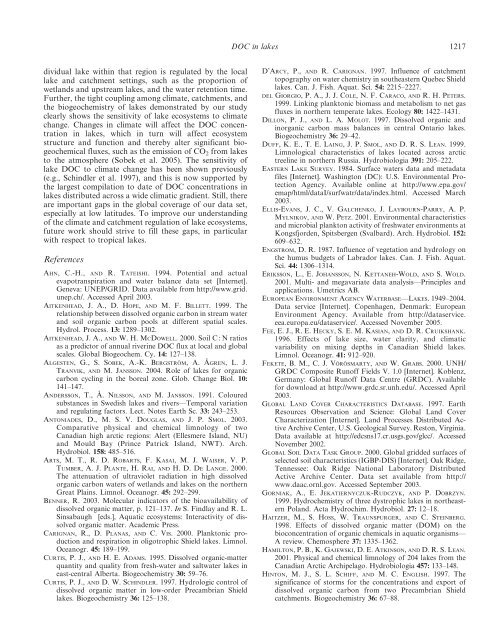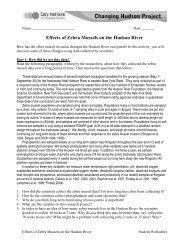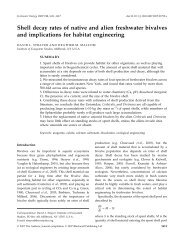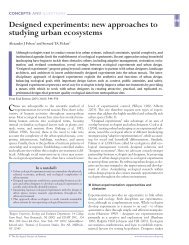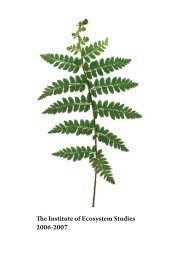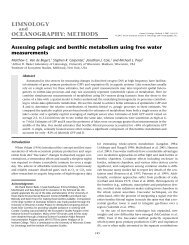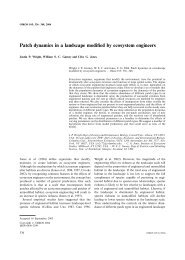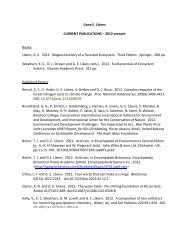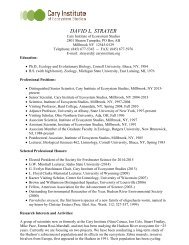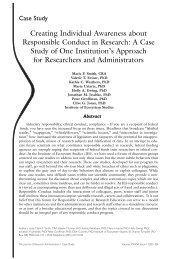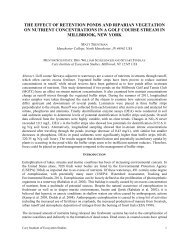Patterns and regulation of dissolved organic carbon
Patterns and regulation of dissolved organic carbon
Patterns and regulation of dissolved organic carbon
You also want an ePaper? Increase the reach of your titles
YUMPU automatically turns print PDFs into web optimized ePapers that Google loves.
DOC in lakes 1217<br />
dividual lake within that region is regulated by the local<br />
lake <strong>and</strong> catchment settings, such as the proportion <strong>of</strong><br />
wetl<strong>and</strong>s <strong>and</strong> upstream lakes, <strong>and</strong> the water retention time.<br />
Further, the tight coupling among climate, catchments, <strong>and</strong><br />
the biogeochemistry <strong>of</strong> lakes demonstrated by our study<br />
clearly shows the sensitivity <strong>of</strong> lake ecosystems to climate<br />
change. Changes in climate will affect the DOC concentration<br />
in lakes, which in turn will affect ecosystem<br />
structure <strong>and</strong> function <strong>and</strong> thereby alter significant biogeochemical<br />
fluxes, such as the emission <strong>of</strong> CO 2 from lakes<br />
to the atmosphere (Sobek et al. 2005). The sensitivity <strong>of</strong><br />
lake DOC to climate change has been shown previously<br />
(e.g., Schindler et al. 1997), <strong>and</strong> this is now supported by<br />
the largest compilation to date <strong>of</strong> DOC concentrations in<br />
lakes distributed across a wide climatic gradient. Still, there<br />
are important gaps in the global coverage <strong>of</strong> our data set,<br />
especially at low latitudes. To improve our underst<strong>and</strong>ing<br />
<strong>of</strong> the climate <strong>and</strong> catchment <strong>regulation</strong> <strong>of</strong> lake ecosystems,<br />
future work should strive to fill these gaps, in particular<br />
with respect to tropical lakes.<br />
References<br />
AHN, C.-H., AND R. TATEISHI. 1994. Potential <strong>and</strong> actual<br />
evapotranspiration <strong>and</strong> water balance data set [Internet].<br />
Geneva: UNEP/GRID. Data available from http://www.grid.<br />
unep.ch/. Accessed April 2003.<br />
AITKENHEAD, J. A., D. HOPE, AND M. F. BILLETT. 1999. The<br />
relationship between <strong>dissolved</strong> <strong>organic</strong> <strong>carbon</strong> in stream water<br />
<strong>and</strong> soil <strong>organic</strong> <strong>carbon</strong> pools at different spatial scales.<br />
Hydrol. Process. 13: 1289–1302.<br />
AITKENHEAD, J. A., AND W. H. MCDOWELL. 2000. Soil C : N ratios<br />
as a predictor <strong>of</strong> annual riverine DOC flux at local <strong>and</strong> global<br />
scales. Global Biogeochem. Cy. 14: 127–138.<br />
ALGESTEN, G., S. SOBEK, A.-K. BERGSTRÖM, A. ÅGREN, L. J.<br />
TRANVIK, AND M. JANSSON. 2004. Role <strong>of</strong> lakes for <strong>organic</strong><br />
<strong>carbon</strong> cycling in the boreal zone. Glob. Change Biol. 10:<br />
141–147.<br />
ANDERSSON, T., Å. NILSSON, AND M. JANSSON. 1991. Coloured<br />
substances in Swedish lakes <strong>and</strong> rivers—Temporal variation<br />
<strong>and</strong> regulating factors. Lect. Notes Earth Sc. 33: 243–253.<br />
ANTONIADES, D., M. S. V. DOUGLAS, AND J. P. SMOL. 2003.<br />
Comparative physical <strong>and</strong> chemical limnology <strong>of</strong> two<br />
Canadian high arctic regions: Alert (Ellesmere Isl<strong>and</strong>, NU)<br />
<strong>and</strong> Mould Bay (Prince Patrick Isl<strong>and</strong>, NWT). Arch.<br />
Hydrobiol. 158: 485–516.<br />
ARTS, M. T., R. D. ROBARTS, F. KASAI, M. J. WAISER, V. P.<br />
TUMBER, A.J.PLANTE, H.RAI, AND H. D. DE LANGE. 2000.<br />
The attenuation <strong>of</strong> ultraviolet radiation in high <strong>dissolved</strong><br />
<strong>organic</strong> <strong>carbon</strong> waters <strong>of</strong> wetl<strong>and</strong>s <strong>and</strong> lakes on the northern<br />
Great Plains. Limnol. Oceanogr. 45: 292–299.<br />
BENNER, R. 2003. Molecular indicators <strong>of</strong> the bioavailability <strong>of</strong><br />
<strong>dissolved</strong> <strong>organic</strong> matter, p. 121–137. In S. Findlay <strong>and</strong> R. L.<br />
Sinsabaugh [eds.], Aquatic ecosystems: Interactivity <strong>of</strong> <strong>dissolved</strong><br />
<strong>organic</strong> matter. Academic Press.<br />
CARIGNAN, R., D. PLANAS, AND C. VIS. 2000. Planktonic production<br />
<strong>and</strong> respiration in oligotrophic Shield lakes. Limnol.<br />
Oceanogr. 45: 189–199.<br />
CURTIS, P. J., AND H. E. ADAMS. 1995. Dissolved <strong>organic</strong>-matter<br />
quantity <strong>and</strong> quality from fresh-water <strong>and</strong> saltwater lakes in<br />
east-central Alberta. Biogeochemistry 30: 59–76.<br />
CURTIS, P. J., AND D. W. SCHINDLER. 1997. Hydrologic control <strong>of</strong><br />
<strong>dissolved</strong> <strong>organic</strong> matter in low-order Precambrian Shield<br />
lakes. Biogeochemistry 36: 125–138.<br />
D’ARCY, P., AND R. CARIGNAN. 1997. Influence <strong>of</strong> catchment<br />
topography on water chemistry in southeastern Quebec Shield<br />
lakes. Can. J. Fish. Aquat. Sci. 54: 2215–2227.<br />
DEL GIORGIO, P. A., J. J. COLE, N.F.CARACO, AND R. H. PETERS.<br />
1999. Linking planktonic biomass <strong>and</strong> metabolism to net gas<br />
fluxes in northern temperate lakes. Ecology 80: 1422–1431.<br />
DILLON, P. J., AND L. A. MOLOT. 1997. Dissolved <strong>organic</strong> <strong>and</strong><br />
in<strong>organic</strong> <strong>carbon</strong> mass balances in central Ontario lakes.<br />
Biogeochemistry 36: 29–42.<br />
DUFF, K. E., T. E. LAING, J.P.SMOL, AND D. R. S. LEAN. 1999.<br />
Limnological characteristics <strong>of</strong> lakes located across arctic<br />
treeline in northern Russia. Hydrobiologia 391: 205–222.<br />
EASTERN LAKE SURVEY. 1984. Surface waters data <strong>and</strong> metadata<br />
files [Internet]. Washington (DC): U.S. Environmental Protection<br />
Agency. Available online at http://www.epa.gov/<br />
emap/html/dataI/surfwatr/data/index.html. Accessed March<br />
2003.<br />
ELLIS-EVANS, J. C., V. GALCHENKO, J.LAYBOURN-PARRY, A.P.<br />
MYLNIKOV, AND W. PETZ. 2001. Environmental characteristics<br />
<strong>and</strong> microbial plankton activity <strong>of</strong> freshwater environments at<br />
Kongsfjorden, Spitsbergen (Svalbard). Arch. Hydrobiol. 152:<br />
609–632.<br />
ENGSTROM, D. R. 1987. Influence <strong>of</strong> vegetation <strong>and</strong> hydrology on<br />
the humus budgets <strong>of</strong> Labrador lakes. Can. J. Fish. Aquat.<br />
Sci. 44: 1306–1314.<br />
ERIKSSON, L., E. JOHANSSON, N.KETTANEH-WOLD, AND S. WOLD.<br />
2001. Multi- <strong>and</strong> megavariate data analysis—Principles <strong>and</strong><br />
applications. Umetrics AB.<br />
EUROPEAN ENVIRONMENT AGENCY WATERBASE—LAKES. 1949–2004.<br />
Data service [Internet]. Copenhagen, Denmark: European<br />
Environment Agency. Available from http://dataservice.<br />
eea.europa.eu/dataservice/. Accessed November 2005.<br />
FEE, E. J., R. E. HECKY, S.E.M.KASIAN, AND D. R. CRUIKSHANK.<br />
1996. Effects <strong>of</strong> lake size, water clarity, <strong>and</strong> climatic<br />
variability on mixing depths in Canadian Shield lakes.<br />
Limnol. Oceanogr. 41: 912–920.<br />
FEKETE, B. M., C. J. VÖRÖSMARTY, AND W. GRABS. 2000. UNH/<br />
GRDC Composite Run<strong>of</strong>f Fields V. 1.0 [Internet]. Koblenz,<br />
Germany: Global Run<strong>of</strong>f Data Centre (GRDC). Available<br />
for download at http://www.grdc.sr.unh.edu/. Accessed April<br />
2003.<br />
GLOBAL LAND COVER CHARACTERISTICS DATABASE. 1997. Earth<br />
Resources Observation <strong>and</strong> Science: Global L<strong>and</strong> Cover<br />
Characterization [Internet]. L<strong>and</strong> Processes Distributed Active<br />
Archive Center, U.S. Geological Survey. Reston, Virginia.<br />
Data available at http://edcsns17.cr.usgs.gov/glcc/. Accessed<br />
November 2002.<br />
GLOBAL SOIL DATA TASK GROUP. 2000. Global gridded surfaces <strong>of</strong><br />
selected soil characteristics (IGBP-DIS) [Internet]. Oak Ridge,<br />
Tennessee: Oak Ridge National Laboratory Distributed<br />
Active Archive Center. Data set available from http://<br />
www.daac.ornl.gov. Accessed September 2003.<br />
GORNIAK, A., E. JEKATIERNYCZUK-RUDCZYK, AND P. DOBRZYN.<br />
1999. Hydrochemistry <strong>of</strong> three dystrophic lakes in northeastern<br />
Pol<strong>and</strong>. Acta Hydrochim. Hydrobiol. 27: 12–18.<br />
HAITZER, M., S. HOSS, W. TRAUNSPURGER, AND C. STEINBERG.<br />
1998. Effects <strong>of</strong> <strong>dissolved</strong> <strong>organic</strong> matter (DOM) on the<br />
bioconcentration <strong>of</strong> <strong>organic</strong> chemicals in aquatic organisms—<br />
A review. Chemosphere 37: 1335–1362.<br />
HAMILTON, P. B., K. GAJEWSKI,D.E.ATKINSON, AND D. R. S. LEAN.<br />
2001. Physical <strong>and</strong> chemical limnology <strong>of</strong> 204 lakes from the<br />
Canadian Arctic Archipelago. Hydrobiologia 457: 133–148.<br />
HINTON, M. J., S. L. SCHIFF, AND M. C. ENGLISH. 1997. The<br />
significance <strong>of</strong> storms for the concentrations <strong>and</strong> export <strong>of</strong><br />
<strong>dissolved</strong> <strong>organic</strong> <strong>carbon</strong> from two Precambrian Shield<br />
catchments. Biogeochemistry 36: 67–88.


